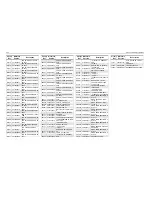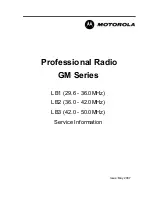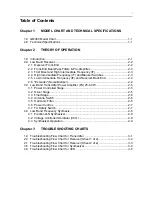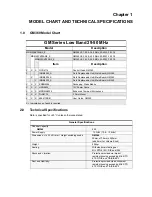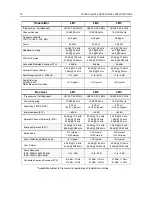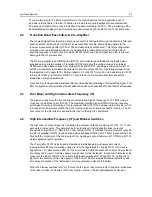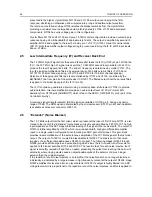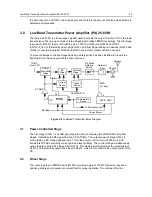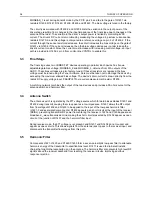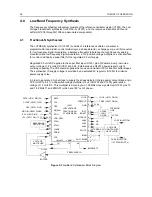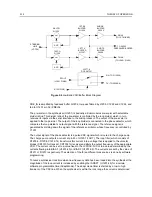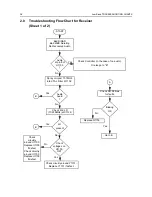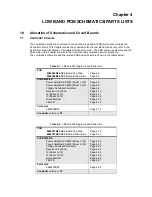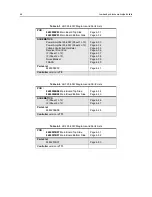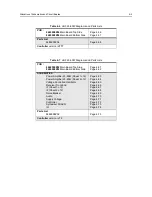
Low Band Transmitter Power Amplifier (PA) 25-60 W
2-7
3.6
Power Control
The transmitter uses the Power Control IC (PCIC, U1503) to control the power output of the radio. A
differential DC amplifier U1502-1 compares the voltage drop across current-measuring resistor
R1409, which is proportional to the transmitter final stage DC current, with the voltage drop across
resistor R1508 and R1535, which is proportional to the current through transistor Q1503. This
transistor is controlled by the output of the differential amplifier, which varies the transistor Q1503.
This transistor is controlled by the output of the differential amplifier, which varies the transistor
current until equilibrium of the two compared voltages is reached. The current through Q1503
develops a voltage across R1513 which is exactly proportional to the DC current of the final stages.
This voltage is applied to the RF IN port of the PCIC (pin 1).
The PCIC has internal digital to analog converters (DACs) which provide a reference voltage of the
control loop. The reference voltage level is programmable through the SPI line of the PCIC. This
reference voltage is proportional to the desired power setting of the transmitter, and is factory
programmed at several points across the frequency range of the transmitter to offset frequency
response variations of the transmitter’s power detector circuitry.
The PCIC provides a DC output voltage at pin 4 (INT) which is amplified and shifted in DC level by
stages Q1504 and Q1505. The 0 to 4 volt DC range at pin 4 of U1503 is translated to a 0 to 8 volt
DC range at the output of Q1505, and applied as VCNTRL to the power-adjust input pin of the first
transmitter stage U1401. This adjusts the transmitter power output to the intended value. Variations
in antenna impedance cause variations in the DC current of the final stages, and the PCIC adjusts
the control voltage above or below its nominal value to reduce power if current drain increases, or
raise power if current drain decreases.
Capacitors C1503-4 and C1525, in conjunction with resistors and integrators within the PCIC,
control the transmitter power-rise (key-up) and power-decay (de-key) characteristic to minimize
splatter into adjacent channels.
U1501 is a temperature-sensing device which monitors the circuit board temperature in the vicinity
of the transmitter circuits and provides a dc voltage to the PCIC (TEMP, pin 29) proportional to
temperature. If the DC voltage produced exceeds the set threshold in the PCIC, the transmitter
output power will be reduced so as to reduce the transmitter temperature.
3.7
TX Safety Switch
The TX Safety Switch consists of S1501, Q1506, and diode pairs D1502 and D1503 providing
protection to the Þnal stage divices Q1402 and Q1403. These Þnal stage devices can be degraded
or destroyed if the radio is keyed without the cover in place due to the lack of a good thermal path to
the chassis.
Switch S1501 is closed when the radio´s cover is screwed in place by means of the carbonized
reqion on the cover´s pressure pad making contact with the longer plating on the radio´s PCB. With
the cover in place, transistor Q1506 is off, back-biasing diodes D1502 and D1503, enabling proper
transmitter operation. When the cover is not in place, S1501 opens, causing Q1506 to rurn on,
pulling the cathodes of D1502 and D1503 to ground, resulting in the shorting of the transmitter´s
bias lines and control voltage.
Summary of Contents for 6864115B62-C
Page 1: ...Professional Radio GM Series Detailed Service Manual 6864115B62 C ...
Page 2: ...ii ...
Page 4: ...iv ...
Page 5: ...Professional Radio GM Series Service Maintainability Issue July 2007 ...
Page 8: ...ii ...
Page 22: ...2 10 MAINTENANCE ...
Page 25: ...Professional Radio GM Series Controlhead Service Information Issue July 2007 ...
Page 77: ...Professional Radio GM Series Controller Service Information Issue May 2007 ...
Page 100: ...2 2 TROUBLESHOOTING CHARTS ...
Page 104: ...3 4 Controller schematics parts list ...
Page 154: ...3 52 Controller T12 Schematic Diagrams ...
Page 155: ...Professional Radio GM Series VHF 136 174MHz Service Information Issue May 2007 ...
Page 164: ...1 6 MODEL CHART AND TECHNICAL SPECIFICATIONS ...
Page 176: ...2 12 THEORY OF OPERATION ...
Page 186: ...3 10 TROUBLESHOOTING CHARTS ...
Page 190: ...4 4 VHF PCB SCHEMATICS PARTS LISTS ...
Page 252: ...4 66 VHF 1 25W PCB 8471235L02 Schematics VHF 136 174 MHz IF ...
Page 256: ...4 70 VHF 1 25W PCB 8471235L02 Schematics ...
Page 257: ...Professional Radio GM Series UHF 403 470MHz Service Information Issue May 2007 ...
Page 266: ...1 6 MODEL CHART AND TECHNICAL SPECIFICATIONS ...
Page 366: ...2 12 THEORY OF OPERATION ...
Page 372: ...3 6 Low Band TROUBLESHOOTING CHARTS ...


